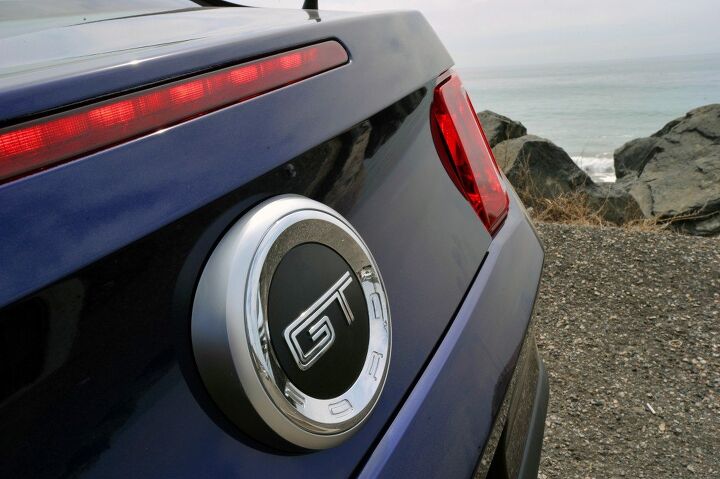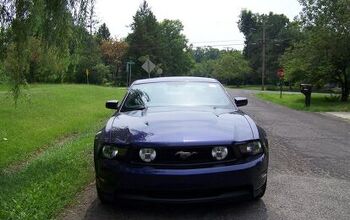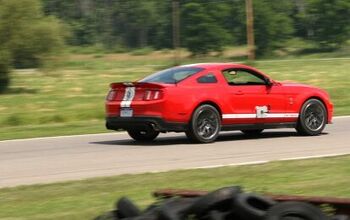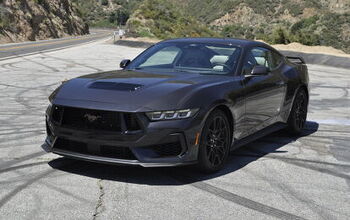Review: 2011 Ford Mustang GT

Powered By Ford. There’s something special about those words, something iconic, something that evokes a grand American scope, from the first cross-country trips in a Model T to a majestic GT40 hammering down the rain-soaked Mulsanne straight. Powered by Ford. It’s the logo stamped into the cam covers of the five-liter Mustang, but you won’t need to raise the hood to understand what it means. The first time this majestic engine swallows through its thirty-two adjustably timed valves and bellows a crescendo through its twin exhaust, it will be more than crystal clear.
Down Topanga Canyon Road, I can see the road is clear several switchbacks below. I loaf along, watching and timing, waiting for the moment when I have seen
everything before me. Then I drop to third gear and let this new 2011 Mustang sing to seven thousand revs. The acceleration is shocking, as is the maddened “whoop” which fills the cabin. In no time my co-driver and I have swallowed seas of traffic, fast-forwarding the windshield view to a blur, an F-15 in a sky of Cessnas. I could go on, but this is TTAC and therefore convention requires that I discuss price and value.
The price is pretty good. Under thirty grand puts you into a 5.0. Equip the car with the bare necessities — Brembo front brakes, 3.73 axle, and a deleted rear spoiler — and the cash register rings to the tune of $32,980. This is the equivalent of Frank Bullit’s old 390GT, but make no mistake: with a conservatively-rated 412 horsepower, this car would rip the lungs from the Highland Green hubcap-eater. E92 M3 owners should worry. C5 Z06 pilots will need to find a twisty road lest they be run nose-to-tail down long freeway sprints.
Not that this revamped Mustang is helpless or hopeless on those twisty roads. As with the Mercedes SL, the faster variants are increasingly numb at the helm due to greater engine weight. Consider this the SL63 of the range; strong enough for virtually any fast-road duty but without the extra weight and ponderousness of the forced-induction version. Turn-in is light but feedback through the EPAS is surprisingly good, no doubt aided by the 19-inch P-Zero Neros. Nineteens are standard on Brembo-package cars and the California Specials. I’d prefer to combine the lighter eighteen-inch wheels with the Brembos, even at the sacrifice of 235-width tires against the 245-width big-wheels, but Ford does not offer that particular combination.
Once in the turn, the five-liter is torquey enough to adjust the cornering attitude at will. I suspect that the stability control intervenes when brakes are applied, even when it’s supposedly turned all the way off. With that said, I’m not a newspaper journo and it’s not really in my bag of tricks to stomp the brake in mid-corner. Left-foot braking into the corner is dicey enough; the Brembos are nice but they are still two sizes too small for a car of this performance potential.
It is nearly impossible to overstate the sheer charisma of this engine. Dyed-in-the-wool import snobs will simply adore the way it builds power along the rev range. It feels like the big-money four-or-five-liter engines from Audi, BMW, and Jaguar, but there’s an American helping of torque thanks to the Ti-VCT clever cams.
While the original Fox GT 5.0 was in many ways simply a flexible platform for a sterling engine, however, this Mustang continues Ford’s march of refinement. NVH is down. Interior quality is up, measurably so in these pre-production cars compared to the GT 4.6 I drove last year. SYNC is available and recommended to all but the most feverish of Luddites. The “MyKey” electronic nanny is available as well, but no amount of technology will keep teenagers from dying in this car if the conditions are wrong. It’s simply too quick to be
entrusted to the inexperienced.
The rest of the car is a Mustang, and more or less as we know it: shiny metal interior, vaguely retro styling laid atop decidedly retro packaging, low seating position, decent visibility, and stronger-than-Corolla inputs required at all controls. As with the V-6, there’s a bit of a fuel-economy story here: twenty-six miles per gallon for a stick-shift with the standard rear axle.
There are few things about this car that will not be apparent during a casual test drive, and it is worth passing them along to TTAC readers. These Mustangs don’t feel natural to those of us used to perching over transverse motors in a cab-forward arrangement, but after a few dozen miles one adjusts very well and begins to enjoy being in the longitudinal center of the car. This is a fast, competent, well-sorted performance car that delivers M3-level performance at half the price. That will seal the deal for many drivers, even initially skeptical ones, but I cannot lie: they had me at “Powered”.
[Jack Baruth attended the launch for the Mustang, which was paid for by Ford]

More by Jack Baruth
Latest Car Reviews
Read moreLatest Product Reviews
Read moreRecent Comments
- Kwik_Shift_Pro4X Save your money and just keep the car.
- MaintenanceCosts Good stuff. I miss my LS, although it was not as bulletproof as your GS has been, having experienced suspension issues and a premature water pump leak. Lexus knows how to do a comfy sedan.
- Dartman Nice write up. Well maintained garaged cars easily last 15+ years (
- Redapple2 The VW saga is well remembered. Ug. RE your Lexus, with such a long refuel interval I d burn only E 0. Some of your E 10 in the tank may be from 6 mo ago.
- 28-Cars-Later The CD player is glorious. Edit: Also really nice job on the initial shot. I'm not sure if you had any training in photography but it looks professional.






































Comments
Join the conversation
I have a 2009 Infiniti G37S Coupe with the manual trans. I'm seriously thinking about getting a 2012 Mustang GT, also with manual trans. I haven't had a chance to test drive the Stang because the ones on hand had Auto trans. On paper, the Mustang has nearly 100hp over the G37S and a lot more torque. The Mustang gets about the same gas mileage and runs on regular. I drive on twisty roads fairly often with the Infiniti and it is a real joy. I wonder what the Mustang driving experience would be like in comparison to the Infiniti? I'm sure the power would be intoxicating, but I'm not sure about the handling. Both cars have nearly useless back seats which I don't use anyway. The lower quality of interior bits in the Mustang wouldn't bother me as long as it doesn't rattle, and buzz, and scream "cheap" on every bump. I'm high on the Mustang now, but I wonder if it would be foolish to trade-in my near perfect and very low mileage Infiniti to get one and then regret it later? Like the Infiniti, the Mustang would only be driven on weekends in good weather.
Who doesn't love classic. I myself turn mine into hot rod, installing chrome wheels from originalwheel.com made it look a killer. There are many ways doing designing on these beauties. It's just a car that is open to many kinds of designing.